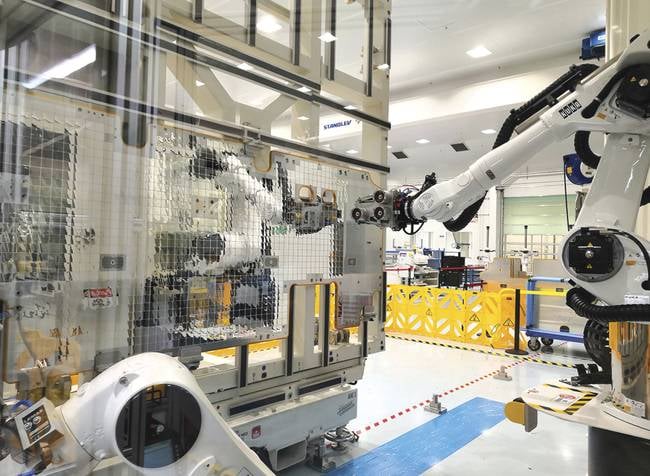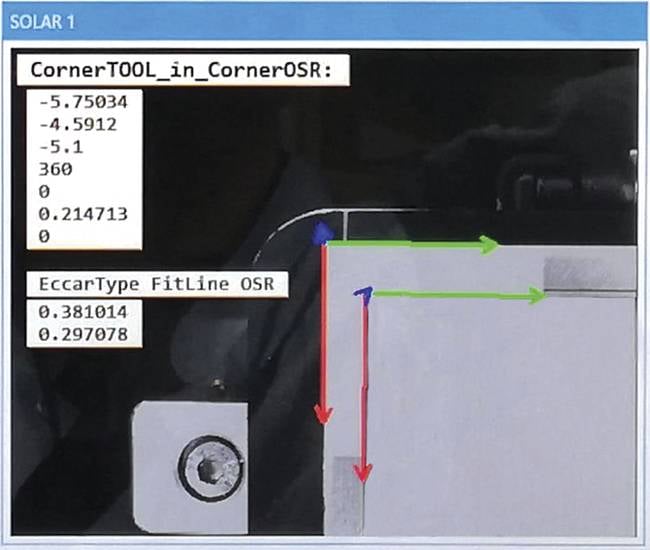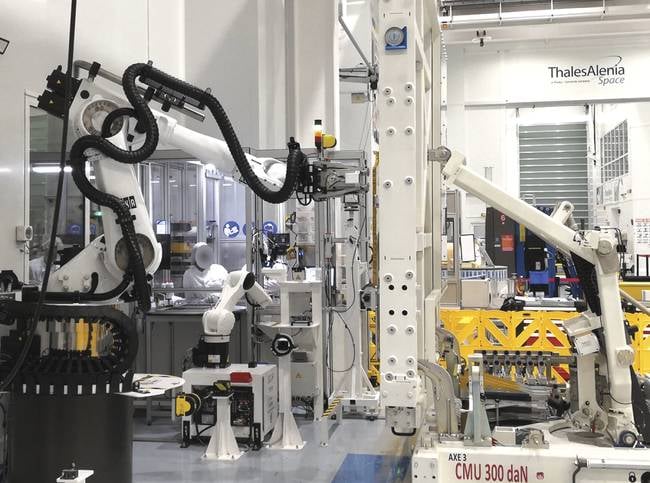DOMINIC V. ACQUISTA, DEPARTMENTS EDITOR
An optical solar reflector (OSR), or a second surface mirror, is a critical thermal control element that protects satellites in high-radiation environments, such as geostationary orbits. Traditionally, OSRs have been mounted on satellite panels by hand. Two or more workers would have the meticulous task of positioning the OSR strips and ensuring that they
were correctly aligned.
To make the process more efficient, automation company AKEOPLUS, in coordination with space manufacturer Thales Alenia Space, developed a robotic solution for manufacturing satellite panels. The robotic cell nicknamed “SOLAR” fits OSRs onto satellites in a confined working area in a cleanroom environment. To help with accuracy, AKEOPLUS relied on MVTec’s HALCON machine vision software to assist with inspection tasks and the alignment of the OSRs.

The satellite panels where the optical solar reflectors (OSRs) are placed. The OSRs are used to help satellites survive a high-radiation environment by reflecting the radiation. Courtesy of AKEOPLUS.
The panels, which have an area of 6 × 3 m, are each contained within a working area of 7 × 5 m per SOLAR cell. Here, the robots are tasked with applying up to 7000 40- × 43-mm OSRs to the panels with an accuracy of <0.2 mm. “The robot cannot make movements as small as we need,” said Maxime Motisi, CFO and project manager of the SOLAR robotic cell at AKEOPLUS. He said the same is true for humans completing the work, citing reasons in ergonomics.
The difference between the two methods, however, is that both AKEOPLUS and Thales Alenia Space were able to make up for a lack of accuracy in the robots through innovation.
Manufacturing with SOLAR cells
Each SOLAR robotic cell contains two integrated robots as well as a positioning table on which the satellite panels are placed. A laser tracker is responsible for accurately guiding a six-axis robotic arm while three high-resolution 2D cameras are used on the hardware side for industrial image processing. The HALCON machine vision software is responsible for the quality inspection of the OSR, fine positioning, human-machine interface, and visualization.
Motisi said that the combination of the machine vision end of the cell with the laser tracker creates a precise dimension chain that allows AKEOPLUS to develop a visual servoing between both the actual robot and target position.
During the manufacturing process, the smaller of the two robots places an OSR on a vacuum backlight under the first camera station. The picture taken by the cameras is then inspected for breaks and scratches with the HALCON software. Shape-based matching, a machine vision method that allows the user to localize objects based on a single model image, is used to determine the exact position of the OSR and to check whether the size and shape of the component corresponds to the intended model.
After the OSR is aligned by HALCON within an accuracy of ∼0.2 mm, glue is added to the reflector and placed in a post where the larger of the two robots of the SOLAR cell takes over. It transports the OSR to a processing station where HALCON analyzes the glue pattern and checks whether the glue is evenly distributed in respect to a specific predefined pattern.
Alignment with coordinates
Next in the manufacturing process is the precise alignment of the OSR to the arm of the robot at the third camera station. HALCON’s algorithms determine the 3D transformation between the coordinates of the OSR corner and the coordinate system of the robot’s gripper that holds the OSR by a vacuum gripping system.
The corners of the OSR are determined by the intersection of the edges. Derived from this, a coordinate system can be defined with the corner of the OSR as the center point, which is aligned with the edges of the OSR. The coordinate system of the effector robot can be determined in advance by hand-eye calibration of the robot.
There are a couple of reasons why creating a coordinate system is important to the overall process as determined by AKEOPLUS. For one, it helps 3D alignment because the reflector on the gripper might be tilted. The corners of the OSR are compared with those of the effector, which identifies each corner and allows them to act as reference points, compensating for minimal tilts and shifts. Second, the corner of the OSR serves as a reference point for its placement on the panel.
With the laser tracker in conjunction with HALCON, the servoing process enables the robot to mount the OSR to the exact location on the 18-sq-m panel with the required accuracy and compensation for any inaccuracies.
Lighting the system
According to Motisi, AKEOPLUS had previously tested different modes of lighting during a study in 2017.

The HALCON software measures the corners of each optical solar reflector (OSR) to determine quality control and to tell the robotic arms of the SOLAR cell where to retrieve the OSR. Courtesy of AKEOPLUS.
This means that they were prepared to use different lighting techniques to ensure that the cameras and, in turn, HALCON software could read and identify the OSRs within a reasonable deviation.
The backlighting, as mentioned, was set up for inspection and dimension purposes when searching for initial defects in the reflectors, but low-angle lighting was chosen for the other camera stations. Regarding relocating the OSRs between stations, “[The OSR] is a plane, so it’s black on the camera, and thus we can easily extract the OSR corner from a light background,” Motisi said.
During the inspection process of the glue, blue light was used in conjunction with low-angle lighting because the contrasting colors made it easier to identify the white glue on the reflector’s mirrored surface.
Current and future implementation
The SOLAR cells in combination with the HALCON system have a reported overall equipment effectiveness of >95%, according to AKEOPLUS. This is based on a metric of one large panel being completely covered in OSRs by a single employee over five days. This is compared to the previous manufacturing process, in which two employees took around seven days to complete the same panel.

The SOLAR cell robots place the optical solar reflectors (OSRs) on the satellite panels with an accuracy of <0.2 mm. In the end, the cell had an overall equipment effectiveness of >95% compared with previous manual attempts. Courtesy of AKEOPLUS.
Features such as 3D positional determinations and subpixel-accurate shape-based matching are reasons highlighted by AKEOPLUS that help make the processes easier and able to be integrated into its systems.
“AKEOPLUS uses HALCON in almost every innovating machine we make,” Motisi said. According to him, ∼75% of the company’s use of HALCON is for relocating 6D robots in either 2D or 3D; 15% of the time, HALCON is used in inspection applications, including quality, dimensional, and the presence of a desired component, while 10% of the time, it is applicable to bin picking and collision avoidance.